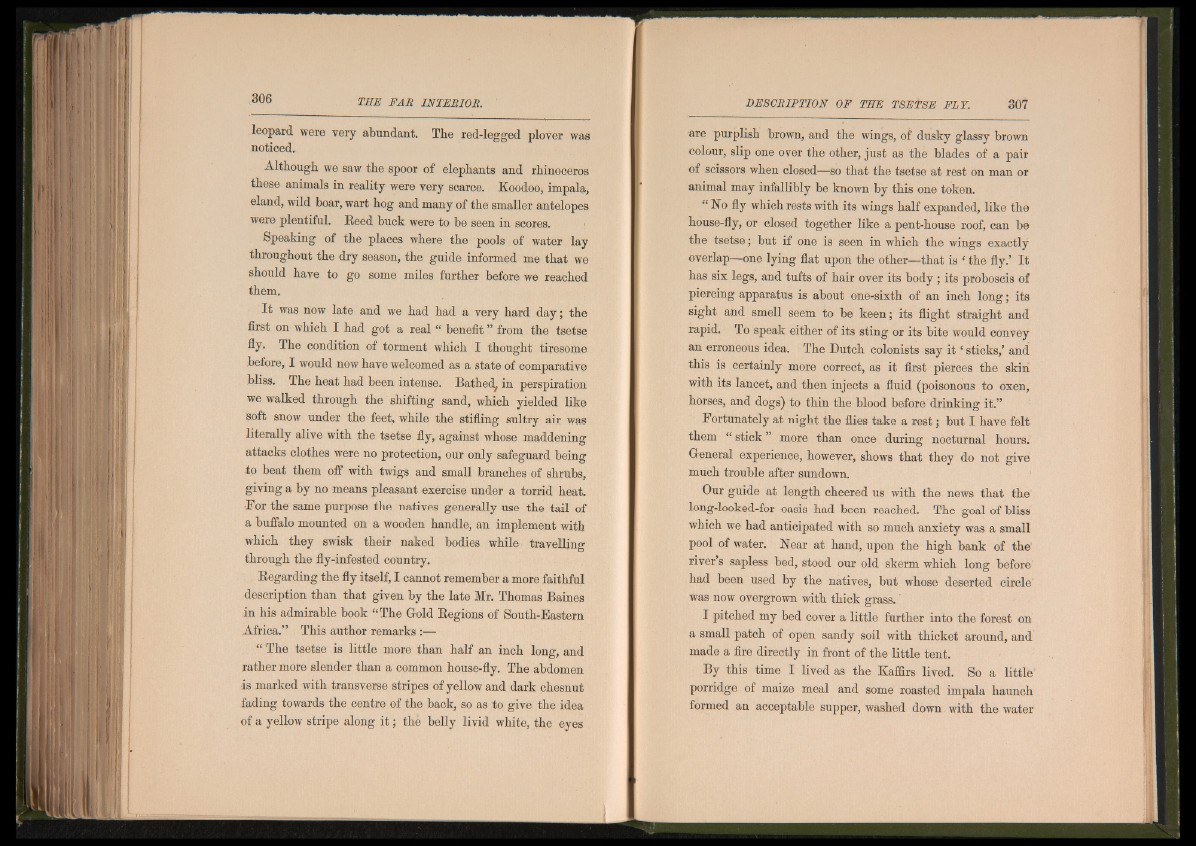
leopard were very abundant. The red-legged plover was
noticed.
Although we saw the spoor of elephants and rhinoceros
these animals in reality were very scarce. Koodoo, impair,
eland, wild boar, wart hog and many of the smaller antelopes
were plentiful. Reed buck were to be seen in scores.
Speaking of the places where the pools of water lay
throughout the dry season, the guide informed me that we
should have to go some miles further before we reached
them.
I t was now late and we had had a very hard day; the
first on which I had got a real “ benefit ” from the tsetse
fly. The condition of torment which I thought tiresome
before, I would now have welcomed as a state of comparative
bliss. The heat had been intense. Bathed^ in perspiration
we walked through the shifting sand, which yielded like
soft snow under the feet, while the stifling sultry air was
literally alive with the tsetse fly, against whose maddening
attacks clothes were no protection, our only safeguard being
to beat them off with twigs and small branches of shrubs,
giving a by no means pleasant exercise under a torrid heat,
•For the same purpose the natives generally use the tail of
a buffalo mounted on a wooden handle, an implement with
which they swisk their naked bodies while travelling
through the fly-infested country.
Regarding the fly itself, I cannot remember a more faithful
description than that given by the late Mr. Thomas Baines
in his admirable book “The Gold Regions of South-Eastern
Africa.” This author remarks
“ The tsetse is little more than half an inch long, and
rather more slender than a common house-fly. The abdomen
is marked with transverse stripes of yellow and dark chesnut
fading towards the centre of the back, so as to give the idea
of a yellow stripe along i t ; the belly livid white, the eyes
are purplish brown, and the wings, of dusky glassy brown
colour, slip one over the other, just as the blades of a pair
of scissors when closed—so that the tsetse at rest on man or
animal may infallibly be known by this one token.
“ No fly which rests with its wings half expanded, like the
house-fly, or closed together like a pent-house roof, can be
the tsetse; but if one is seen in which the wings exactly
overlap—one lying flat upon the other—that is ‘ the fly.’ It
has six legs, and tufts of hair over its body ; its proboscis of
piercing apparatus is about one-sixth of an inch long; its
sight and smell seem to be keen; its flight straight and
rapid. To speak either of its sting or its bite would convey
an erroneous idea. The Dutch colonists say it ‘ sticks,’ and
this is certainly more correct, as it first pierces the skin
with its lancet, and then injects a fluid (poisonous to oxen,
horses, and dogs) to thin the blood before drinking it.”
Fortunately at night the flies take a re s t; but I have felt
them “ stick ” more than once during nocturnal hours.
General experience, however, shows that they do not give
much trouble after sundown.
Our guide at length cheered us with the news that the
long-looked-for oasis had been reached. The goal of bliss
which we had anticipated with so much anxiety was a small
pool of water. Near at hand, upon the high bank of the
river s sapless bed, stood our old skerm which long before
had been used by the natives, but whose deserted circle'
was now overgrown with thick grass.'
I pitched my bed cover a little further into the forest on
a small patch of open sandy soil with thicket around, and
made a fire directly in front of the little tent.
By this time I lived as the Kaffirs lived. So a little
porridge of maize meal and some roasted impala haunch
formed an acceptable supper, washed down with the water